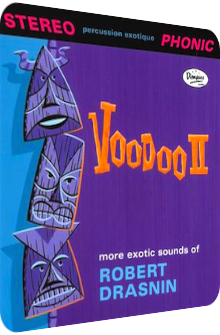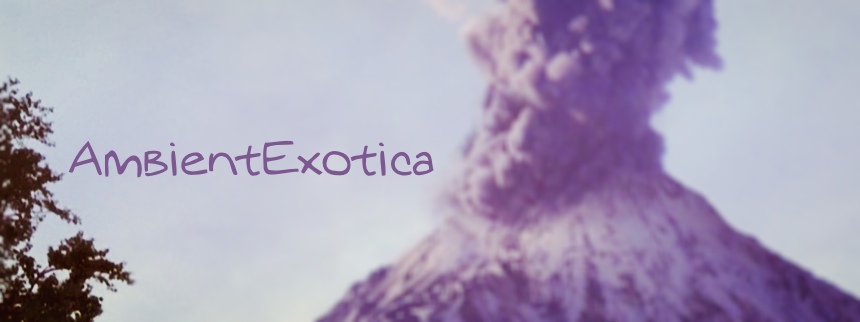
Robert Drasnin
Voodoo II
2007
There it is. The second incarnation of a Voodoo record by Robert Drasnin (1927–2015). The existence of Voodoo II is nothing short of a miracle. A whopping 48 years after the original release of Voodoo!, Robert Drasnin decides to return to the wonderland of Exotica and releases a second rendition consisting of entirely new and original material. The scope of Drasnin‘s return is absolutely awe-inspiring to me and a high point of the whole Exotica genre. It transports all the hopes, dreams and creative urge of one single artist … and leaves out the concept of time completely. It is as if Drasnin finished recording Voodoo! and paused for a few decades, vacationing in the Caribbean.
Naturally, nothing could be farther from the truth: Drasnin was busy with conducting music for over a hundred films and television shows and contributed to The Skip Heller Quartet by playing the saxophone. 2005 marked the sudden return of Drasnin when he performed in the limelight at the Hukilau Festival in Ft. Lauderdale with an orchestra of 16 women and men. Inspired and surprised by the immense feedback and warm reception of the performance, Drasnin went back to the drawing board and prepared drafts for new Exotica songs that would later be recorded in February 2007 – under Skip Heller‘s watchful eye – and gathered together on Voodoo II.
Drasnin was keen to invoke the jazzy but lush spirit of Voodoo! which wasn‘t just recorded in another decade, but another time – The Flintstones weren‘t even on the air back in 1959, let alone had the race to the moon reached its full intensity. The success of the similiarity of Voodoo II to its predecessor, the liner notes by Heller and Exotica expert Jeff Chenault, and finally, the inclusion of Josh Agle‘s alias Shag‘s purple Pop Art are the last pieces of a mosaic full of small serendipities. After elucidating these background situations that led to the album‘s existence, I‘ll concentrate on most of its songs.
Habanera In Blue starts things at a more leisurely pace: a spy movie-like piano backing, distinct bongos, and a beautiful harp mark the beginning of Drasnin‘s latest adventures in Exotica lands. The song also introduces Stephanie Bennett, the sole voice on the album. She takes over the role of Sally Terri who provided the soothing chants in Voodoo! all by herself. Bennett does a great job, though I believe she is not as cheeky as Terri but her voice is all the more soothing instead. The quality of her voice works especially well in this first song as it overlaps with a string instrument, so you cannot tell these audio sources apart – an awesome deception maneuver by Drasnin and the proof of the fact that on his Voodoo records female voices are always used as instruments rather than devices of female self-fulfillments through lyrics.
Moorean Moonbeams is a piano-heavy track with distant claves, bongo percussion and, most importantly, the first strong and hard to forget melody on the album. This song recalls figments of the golden era of Space-Age music, and Bennett‘s voice sounds particularly spacey, almost vocoded. After the Chinese gong marks the end of this song, Sambalerro brings some fresh Latin air to the ears. Once again the song focuses on the piano, but the main melody is played on the cello and a harmonious flute that is played in a similar exuberant style as on Voodoo! – and I shouldn‘t forget Drasnin‘s inclusion of his saxophone that inherits a true Latin feel. An upbeat classic for sure.
East Of Xanadu is another song for Mrs. Bennett to shine: her haunting voice isn‘t an accoutrement but essential for the song as she is singing the main melody. Peggy Baldwin‘s cello takes over the main melody in parts, and the inclusion of the vibraphone is always a big plus for me. The song is only slightly mysterious and actually more ludic and swinging. The end of the song is also noteworthy for its short vibraphone solo. The notes sustain slowly and make room for Kahluha Mist eventually, which picks up the high-note end of East Of Xanadu and features crystal clear vibraphone sprinkles, deep piano accompaniments and a repetition of the melody on clarinet, played by Drasnin himself. This song isn‘t the most upbeat one, but a cozy piece with a welcome focus on mallet instruments.
The second half of the album begins with one of my favorites: the dream-like Luz De La Luna is a polyphonous string song with a gently played sax, allotted glockenspiel sections and gorgeously played pianos that resemble Milt Raskin‘s Kapu LP. The mood of this song is hard to describe, but every part perfectly harmonizes with each other. Puente Doble resembles the structure of a pop song with its definite strophic form which is realized with sneaky pianos, backing vibraphones and hectical percussion. The gorgeous refrain features attenuated pianos and a cheerful vibraphone. The bridge finally consists of a zestfully played harp. Definitely a strong theme.
La Mer Velours doesn‘t just resemble the Exotica feeling of the late 50‘s, but in fact seems to be warped straight from those times into our modern lifestyle. This song perfectly captures the mood: Bennett‘s space-age chants, tubby marimba sounds, jazzy string sections and a euphoric harp help create the lushest of all songs off Voodoo II. Highly recommended as a good track for getting a little taste of what Drasnin has to offer. Reminiscence evokes overly romantic notions with a bittersweet piano melody, quiet percussion, dominant claves and a peaceful flute. The final piece, Tahitian Dream, puts the cello to the forefront, adds hypnotic vocals, lucent vibraphones and radiant glockenspiels. Shortly before the 2-minute mark the piano adds a stream of contentment to the song, and Drasnin plays the saxophone more gently than I could have ever imagined this instrument to sound like. A very nice closer of an album steeped in Exotica history.
John Williams isn‘t on board of Voodoo II – that‘s the album‘s only disadvantage on paper. But he is substituted with the great Mike Lang, and everything else is pitch-perfect, too. Stylistically more varied than Voodoo!, Drasnin masters the balancing act between the adaptation of old times and the integration of wider styles and instruments that were not used on the predecessor, most notably the cello and the synthesizer which is used to mimic a few percussive elements, as well as both samba and bolero rhythms in the respective tracks. Conducted partly by Skip Heller and Robert Drasnin, this is a dream come true for Exotica fans, and I am more than sure that everyone who worked on this project knew exactly what it meant for music history, the revitalization of the genre itself and Robert Drasnin himself.
Yes, I know that this isn‘t an epoch making work of the highest order – no Exotica work is –, but to my mind and lots of other listeners all around the internet, this release is essential even without the knowledge of its background story. The excitement results from the fact that quite a lot of Exotica bands and artists are long gone or have retired and the genre had been almost dead in the funky 70‘s and synth pop 80‘s. Voodoo II, among other albums, proves a rose-tinted future for Exotica afficionados. Maybe I‘m exaggerating, but it is exactly this exaggeration what Exotica (and, ahem, Metal) is mostly about. Voodoo II and its predecessor Voodoo! remain essential items for collectors, fans and for people in general who want to chime in.
Further reading:
Blessed be today‘s modern recording equipment. On YouTube, you will find a few interviews with Robert Drasnin (this one by Jeff Chenault for example) and videos of the Voodoo II recording sessions.
Exotica Review 023: Robert Drasnin – Voodoo II. Originally published on Jan. 14, 2012 at AmbientExotica.com.
